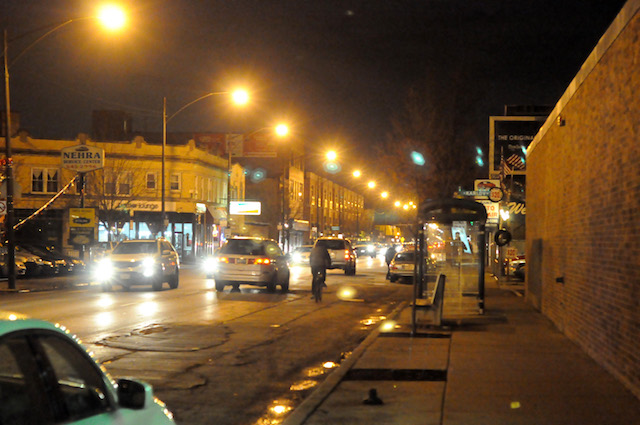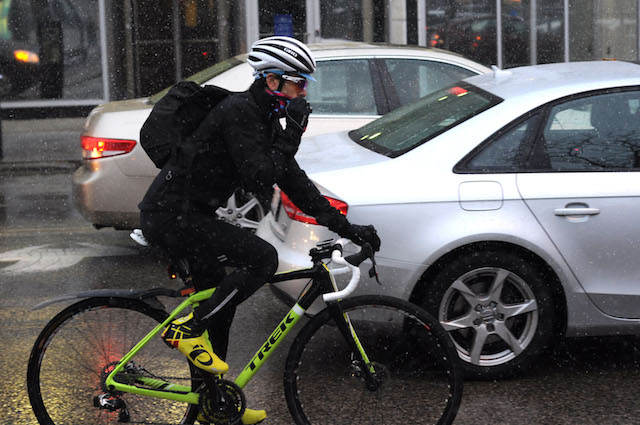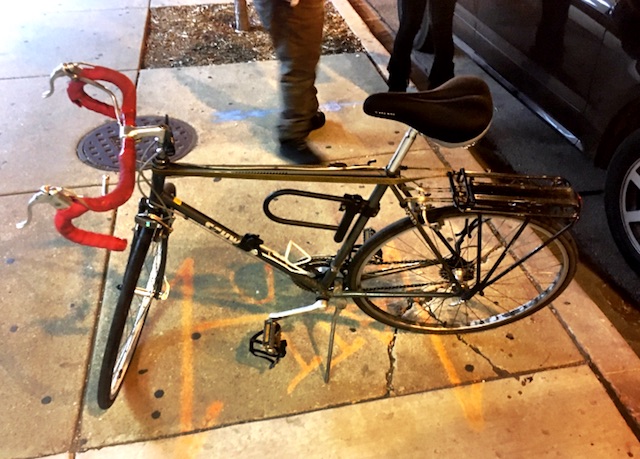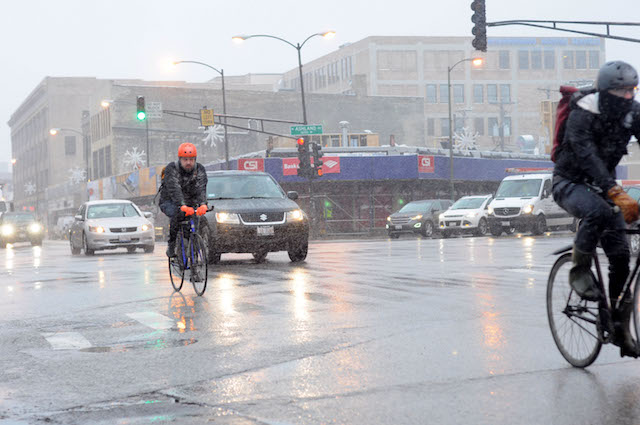5 Key Mistakes To Avoid After A Bike Crash
By Chicagoist_Guest in News on Dec 4, 2015 4:00PM

Even though Milwaukee Avenue is known for its bike traffic, the pavement in neighborhoods like Avondale, Old Irving Park and Portage Park is filled with potholes and cracked pavement. (Photo by Chris Walljasper/Chicagoist)
By Christopher Walljasper
Biking on Milwaukee Avenue during rush hour can offer a false sense of security. Sure, there are cars bumper-to-bumper, honking and jockeying to beat one more red light. But at least a cyclist has company. From Blommer's Chocolate all the way to the Logan Theater, a cyclist is bound to ride with a pack of anywhere between five and a dozen other riders.
But north of Diversey the pack thins out. The bright green bike lanes fade to faint markings on the pavement. Potholes and rough blacktop scar the sad excuse of a bike lane. It's in that rough stretch, during a twilight rush hour a few weeks ago, that I came face to face with the door of a Cadillac.

This is especially tough terrain for a biker. (Photo by Christopher Walljasper/Chicagoist)
There are a few things every cyclist should do when they make contact with a vehicle. Failing to protect yourself after a cycling collision can be as harmful as the impact itself. But in the moment, when heads are throbbing and tempers flaring, it can be hard to remember what to do. It sure was for me, and I made several key mistakes.
Jason Jenkins, the crash support programs manager for the Active Transportation Alliance in Chicago, says the protocol for a bike collision is very similar to the steps that should be followed in a regular car accident. But a cyclist has to be extra diligent to be sure their rights are protected.

A biker riding through traffic (Photo by Christopher Walljasper/Chicagoist)
As the door of the Cadillac flung open, I clenched both brakes and swerved to the left. My right handlebar clipped the edge of the door, and I slid sideways, slamming into the back taillight of a car that was stopped at the red light at Central Park Avenue. I'd been going almost 25 miles per hour and as I dragged my bike out of traffic, my brain was still going a mile a minute.
Mistake #1 - Self-diagnosis
The driver of the SUV followed me onto the sidewalk, and asked if I was hurt. I patted myself down and pulled my helmet off to check for blood. None. I hesitantly told the woman, "I think I'm OK."
Big mistake. "If you don't know if you're hurt or not, tell them you're hurt," says Bob Mionske, an attorney in Portland Oregon. Mionske is also a competitive cyclist and says injuries don't always hurt minutes after the collision. He says it's possible that, "you are hurt—your knee is hurt or you have a concussion or something and you didn't recognize it because of the adrenaline in the moment."
Mistake #2 - Dismissing the witnesses
Another cyclist was just a few yards behind me when the door hit me, and graciously stopped to see if I needed any help. Not trying to be a complainer, I waved him off and reassured him that I was probably fine.
"Typically, the driver's going to have their version, you're going to have your version." Mionske says witnesses aren't just for the courtroom. "If you have no other witnesses, insurance companies are going to say 'it's your word against ours.'" Which will make it much harder to get your property and your medical expenses covered.
Mistake #3 - Trying to negotiate
As soon as it was clear I wasn't maimed, the woman, or more accurately her passenger, switched from apologetic to aggressive. I told the women I wasn’t out to gouge them—I wasn’t even worried about calling the police. I did ask for her insurance information, which was met with even more arguing.
Jenkins says, "Don't take people at their word when they want to handle things off-book." You may seem like the bad guy, but it's better than being the person who is stuck with heavy medical bills and bike repairs when you can't get a hold of the driver weeks later. Jenkins says it's not worth the risk. "It's just better to do things through their normal process."
Mistake #4 - Not demanding an officer show up to the scene
Don't be the nice guy, be the "by-the-books" guy. Call 9-1-1, and be insistent that an officer come to the scene. The dispatcher may not immediately think the situation demands a first-responder.
Brendan Kevenides, a partner at Freeman Kevenides Law Firm which specializes in bicycle collisions, says, in his experience, "The Chicago Police Department is often just awful in the way it responds to bicycle crashes. If they respond at all, they're often strongly discouraging cyclists from creating a report, which is just dead wrong." He says it's best to be polite, yet firm with the dispatcher.
Jenkins says, "It helps if you let them know you need medical assistance."
"If there's any question at all about an injury, especially if you hit your head, helmeted or not, get treatment." Kevenides says "You're so exposed on a bicycle."
As the apologies turned into finger pointing, I finally gave up reasoning and 9-1-1 was called. The dispatcher told us to exchange information and to go to the nearest police station to file a report.
Jenkins says it's important to note that an officer likely won't assign fault in a report, because they didn't witness the collision. But it's important to read through the report before signing it to be sure all the details are correct. That report will be used in any future insurance or court cases.

When I made contact with the door, my handlebars twisted 90 degrees before I hit the second vehicle. The damages to the bike were not initially obvious, but still cost hundreds of dollars. (Photo by Christopher Walljasper/Chicagoist)
Mistake #5 - Not taking pictures of everything
We finally exchanged phone numbers. I took a couple of pictures—her license plate, the door, which had just a few scratches on it, and my bike, unrideable with its handlebars corkscrewed. But I didn't get a picture of her car in relation to the street, or the place where I hit the second car. Getting photographic evidence of the entire scene is important when trying to make a claim with insurance.
"Take some pictures of the collision and where things are parked and how to how the whole situation looked," Mionske says the photos can make or break a person's case. "The whole case comes down to a photo in court, or the lack of a photo."
* * *
I limped my way home, went to an Urgent Care facility, and then finally to the police station. The woman who hit me disappeared into the night. She didn't return my calls or texts, and didn't receive any tickets for the offense. At the police station, I learned that she’d lost her license more than two years earlier, and didn’t have any insurance, which explained the hostility when I asked for her information.
If a police officer had showed up, she likely would've received multiple tickets and I might have had a chance at getting her to pay for my damages. Instead, I'm left dealing with the consequences myself.

A biker on a snowy day crosses Ashland (Photo by Christopher Walljasper/Chicagoist)
What you can do now
Of course prevention is better than prescription, and there are several things cyclists can do to avoid collisions altogether—or to be ready just in case the worst happens.
Be visible and predictable — Jenkins says bright lights and reflective clothing do wonders in avoiding crashes. And following the rules of the road - the rules cars have to abide by - will help keep the peace between motorists and cyclists.

Twilight hours can be some of the most dangerous for a cyclist, especially without proper lights and reflective gear. (Photo by Christopher Walljasper/Chicagoist)
Avoid the Door Zone — Mionske says avoid the far right side of the bike lane. Ride in the middle, or even closer to the left side of the lane.
Get insurance — Kevenides says even you don't own a car, cyclists can get non-auto owner insurance to protect them in accidents. If you do have car insurance, it should cover you in a bike-on-car collision, even if the driver doesn't.
Put this hotline in your phone — Active Transportation Alliance crash support hotline: Jenkins says the help line is open 24/7, to help guide Chicago cyclists through a collision. (312) 869.HELP (4357)
Christopher Walljasper is a faculty instructor at the Medill School of Journalism at Northwestern University. He lives in Portage Park and loves biking to work, walking his basset hound and two kids and discovering hidden eateries on the Northwest Side with his wife.